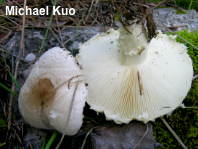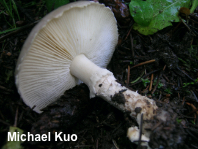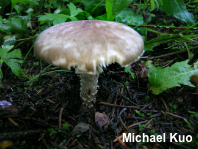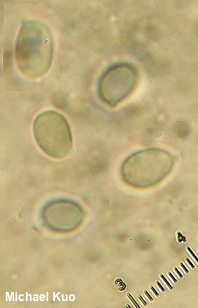| Major Groups > Gilled Mushrooms > Pale-Spored > Floccularia > Floccularia fusca |
| Major Groups > Gilled Mushrooms > Saw-Gilled Mushrooms > Floccularia fusca |

|
Floccularia fusca [ Basidiomycota > Agaricales > Agaricaceae > Floccularia . . . ] by Michael Kuo Apparently limited to the Rocky Mountains, Floccularia fusca is recognized by its gray to pale grayish brown cap, which features a zone of white partial veil remnants along the edge; its white spore print and gills; its stem, which is sheathed in whitish shagginess; and, under the microscope, its smooth, amyloid spores. The species is associated with conifers (Douglas-fir in the northern Rocky Mountains and Engelmann spruce and subalpine fir in the southern Rockies) and is usually found growing alone, or with a few individuals scattered around the same general area. Other species of Floccularia may be found in the same ecosystems, but are differently colored, ranging from brownish yellow to bright yellow—with the exception of a whitish form of Floccularia albolanaripes, which can be separated by the pale yellowish streaks and scales on its cap surface. Armillaria fusca is a previous name. Description: Ecology: Mycorrhizal with conifers, including Douglas-fir in the northern Rocky Mountains and Engelmann spruce and subalpine fir in the southern Rockies; terrestrial, growing alone or scattered; late summer and fall; Rocky Mountains. The illustrated and described collections are from Colorado. Cap: 3–6 cm; convex when young, becoming planoconvex; moist when fresh but soon dry; bald at first but often developing radial, appressed fibrils or scales with age; grayish brown, pale grayish, or nearly whitish; sometimes developing a streaked appearance; the margin often adorned with white partial veil remnants. Gills: Attached to the stem by a notch; close; short-gills frequent; white or creamy. Stem: 3–6 cm long; 0.5–1.5 cm thick; more or less equal, or narrowing a bit toward the base; white and bald near the apex; sheathed below with shaggy zones of soft white scales; sometimes with a collapsed, whitish ring; sometimes developing yellowish discolorations in the basal half with age; basal mycelium white. Flesh: White; not changing on exposure. Odor and Taste: Not distinctive. Chemical Reactions: KOH on cap surface negative to dull orange; iron salts on cap surface negative. Spore Print: White. Microscopic Features: Spores 6–7 x 4–5 µm; ellipsoid; smooth; weakly amyloid. Lamellar trama parallel. Basidia 4-sterigmate. Hymenial cystidia not found. Pileipellis a cutis; elements 5–10 µm wide, smooth, thin-walled, hyaline in KOH; clamp connections present but often small and inconspicuous. REFERENCES: (Mitchel & Smith, 1976) Bon, 1990. (Mitchel & Smith, 1976; Smith, Smith & Weber, 1979; Phillips, 1991/2005; Cripps, Evenson & Kuo, 2016.) Herb. Kuo 08080505, 08150702, 08150703. This site contains no information about the edibility or toxicity of mushrooms. |
© MushroomExpert.Com |
|
Cite this page as: Kuo, M. (2020, January). Floccularia fusca. Retrieved from the MushroomExpert.Com Web site: http://www.mushroomexpert.com/floccularia_fusca.html |



